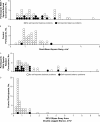Acute Sport-Related Concussion Screening for Collegiate Athletes Using an Instrumented Balance Assessment
- PMID: 29897278
- PMCID: PMC6089035
- DOI: 10.4085/1062-6050-174-17
Acute Sport-Related Concussion Screening for Collegiate Athletes Using an Instrumented Balance Assessment
Abstract
Context: Without a true criterion standard assessment, the sport-related concussion (SRC) diagnosis remains subjective. Inertial balance sensors have been proposed to improve acute SRC assessment, but few researchers have studied their clinical utility.
Objective: To determine if group differences exist when using objective measures of balance in a sample of collegiate athletes with recent SRCs and participants serving as the control group and to calculate sensitivity and specificity to determine the diagnostic utility of the inertial balance sensor for acute SRC injuries.
Design: Cross-sectional cohort study.
Setting: Multicenter clinical trial.
Patients or other participants: We enrolled 48 participants with SRC (age = 20.62 ± 1.52 years, height = 179.76 ± 10.00 cm, mass = 83.92 ± 23.22 kg) and 45 control participants (age = 20.85 ± 1.42 years, height = 177.02 ± 9.59 cm, mass = 74.61 ± 14.92 kg) at 7 clinical sites in the United States. All were varsity or club collegiate athletes, and all participants with SRC were tested within 72 hours of SRC.
Main outcome measure(s): Balance performance was assessed using an inertial balance sensor. Two measures (root mean square sway and 95% ellipse sway area) were analyzed to represent a range of general balance measures. Balance assessments were conducted in double-legged, single-legged, and tandem stances.
Results: A main effect for group was associated with the root mean square sway measure ( F1,91 = 11.75, P = .001), with the SRC group demonstrating balance deficits compared with the control group. We observed group differences in the 95% ellipse sway area measure for the double-legged ( F1,91 = 11.59, P = .001), single-legged ( F1,91 = 6.91, P = .01), and tandem ( F1,91 = 7.54, P = .007) stances. Sensitivity was greatest using a cutoff value of 0.5 standard deviations (54% [specificity = 71%]), whereas specificity was greatest using a cutoff value of 2 standard deviations (98% [sensitivity = 33%]).
Conclusions: Inertial balance sensors may be useful tools for objectively measuring balance during acute SRC evaluation. However, low sensitivity suggests that they may be best used in conjunction with other assessments to form a comprehensive screening that may improve sensitivity.
Keywords: Balance Error Scoring System; inertial sensor; mild traumatic brain injuries.
Figures


Similar articles
-
Evaluation of Nintendo Wii Balance Board as a Tool for Measuring Postural Stability After Sport-Related Concussion.J Athl Train. 2017 Mar;52(3):245-255. doi: 10.4085/1062-6050-52.1.13. J Athl Train. 2017. PMID: 28387551 Free PMC article.
-
Sport-Related Concussion: Knowledge and Reporting Behaviors Among Collegiate Club-Sport Athletes.J Athl Train. 2018 Sep;53(9):866-872. doi: 10.4085/1062-6050-266-17. Epub 2018 Oct 1. J Athl Train. 2018. PMID: 30273011 Free PMC article.
-
Prospective clinical assessment using Sideline Concussion Assessment Tool-2 testing in the evaluation of sport-related concussion in college athletes.Clin J Sport Med. 2015 Jan;25(1):36-42. doi: 10.1097/JSM.0000000000000102. Clin J Sport Med. 2015. PMID: 24915173
-
Reliability and validity evidence of multiple balance assessments in athletes with a concussion.J Athl Train. 2014 Jul-Aug;49(4):540-9. doi: 10.4085/1062-6050-49.3.32. Epub 2014 Jun 16. J Athl Train. 2014. PMID: 24933431 Free PMC article. Review.
-
Postural stability assessment following concussion: one piece of the puzzle.Clin J Sport Med. 2001 Jul;11(3):182-9. doi: 10.1097/00042752-200107000-00009. Clin J Sport Med. 2001. PMID: 11495323 Review.
Cited by
-
Instrumented Static and Reactive Balance in Collegiate Athletes: Normative Values and Minimal Detectable Change.J Athl Train. 2024 Jun 1;59(6):608-616. doi: 10.4085/1062-6050-0403.23. J Athl Train. 2024. PMID: 38014789 Free PMC article.
-
Validity and Reliability of Methods to Assess Movement Deficiencies Following Concussion: A COSMIN Systematic Review.Sports Med Open. 2023 Aug 14;9(1):76. doi: 10.1186/s40798-023-00625-0. Sports Med Open. 2023. PMID: 37578611 Free PMC article.
-
Brainwave Activity Localization, Mood Symptoms, and Balance Impairment in a Male South African Rugby Player With Persisting Symptoms After Concussion: A Case Report.Clin Case Rep. 2025 Feb 10;13(2):e70197. doi: 10.1002/ccr3.70197. eCollection 2025 Feb. Clin Case Rep. 2025. PMID: 39935655 Free PMC article.
-
Single-Legged Hop and Single-Legged Squat Balance Performance in Recreational Athletes With a History of Concussion.J Athl Train. 2020 May;55(5):488-493. doi: 10.4085/1062-6050-185-19. Epub 2020 Mar 27. J Athl Train. 2020. PMID: 32216655 Free PMC article.
-
Wearable Inertial Sensors to Assess Standing Balance: A Systematic Review.Sensors (Basel). 2019 Sep 20;19(19):4075. doi: 10.3390/s19194075. Sensors (Basel). 2019. PMID: 31547181 Free PMC article.
References
-
- Langlois JA, Rutland-Brown W, Wald MM. The epidemiology and impact of traumatic brain injury: a brief overview. J Head Trauma Rehabil. 2006;21(5):375–378. - PubMed
-
- Goldberg LD, Dimeff RJ. Sideline management of sport-related concussions. Sports Med Arthrosc Rev. 2006;14(4):199–205. - PubMed
-
- McCrory P, Meeuwisse W, Dvorak J, et al. Consensus statement on concussion in sport: the 5th International Conference on Concussion in Sport held in Berlin, October 2016. Br J Sports Med. 2017;51(11):838–847. - PubMed
-
- Guskiewicz KM, Broglio SP. Acute sports-related traumatic brain injury and repetitive concussion. Handb Clin Neurol. 2015;127:157–172. - PubMed
Publication types
MeSH terms
LinkOut - more resources
Full Text Sources
Other Literature Sources
Medical
Miscellaneous

